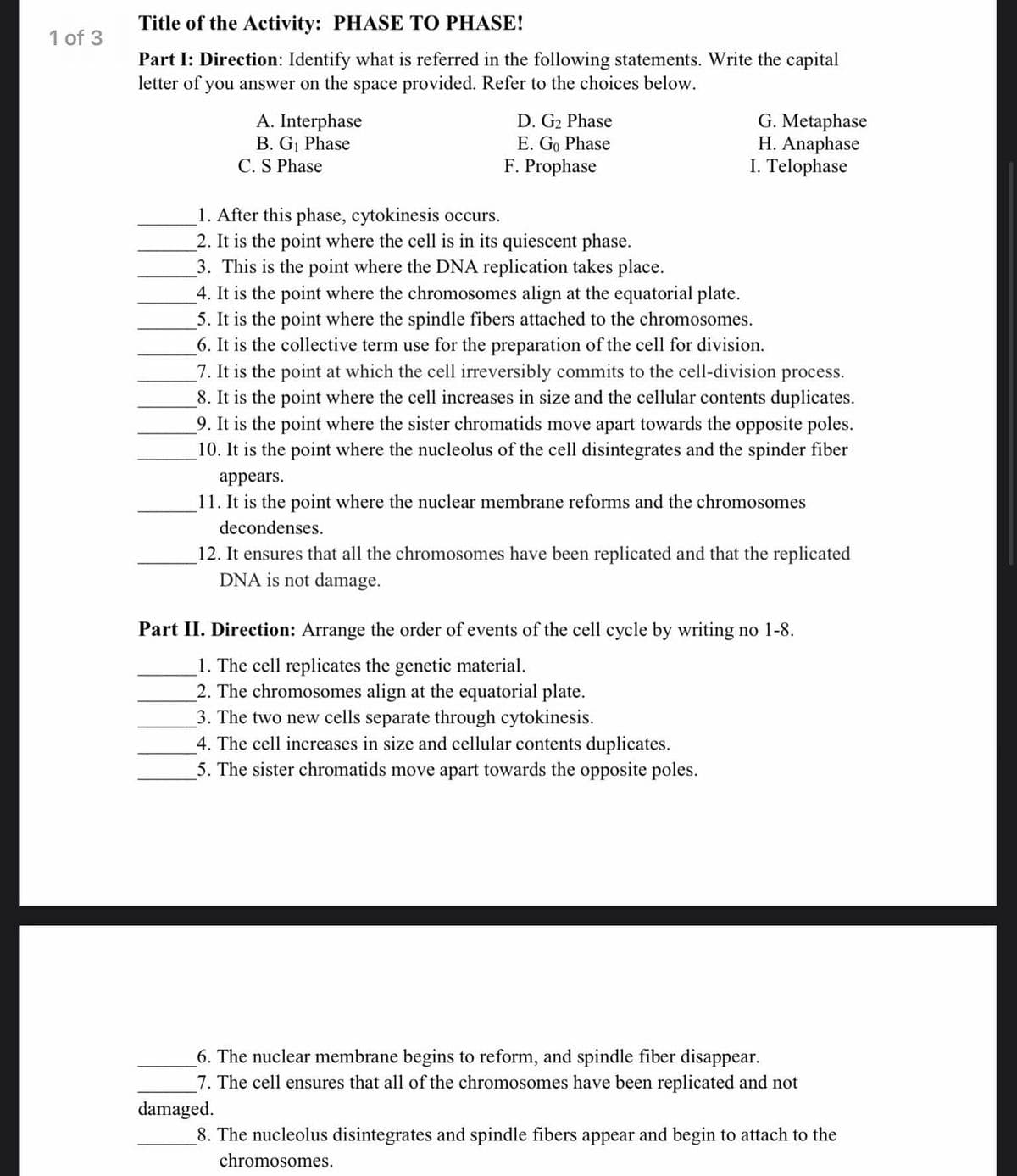Title of the Activity: PHASE TO PHASE! Part I: Direction: Identify what is referred in the following statements. Write the capital letter of you answer on the space provided. Refer to the choices below. A. Interphase B. GI Phase C. S Phase D. G2 Phase E. Go Phase F. Prophase G. Metaphase H. Anaphase I. Telophase 1. After this phase, cytokinesis occurs. 2. It is the point where the cell is in its quiescent phase. _3. This is the point where the DNA replication takes place. _4. It is the point where the chromosomes align at the equatorial plate. 5. It is the point where the spindle fibers attached to the chromosomes. 6. It is the collective term use for the preparation of the cell for division. 7. It is the point at which the cell irreversibly commits to the cell-division process. _8. It is the point where the cell increases in size and the cellular contents duplicates. 9. It is the point where the sister chromatids move apart towards the opposite poles. 10. It is the point where the nucleolus of the cell disintegrates and the spinder fiber аppears. 11. It is the point where the nuclear membrane reforms and the chromosomes decondenses. 12. It ensures that all the chromosomes have been replicated and that the replicated DNA is not damage.
Title of the Activity: PHASE TO PHASE! Part I: Direction: Identify what is referred in the following statements. Write the capital letter of you answer on the space provided. Refer to the choices below. A. Interphase B. GI Phase C. S Phase D. G2 Phase E. Go Phase F. Prophase G. Metaphase H. Anaphase I. Telophase 1. After this phase, cytokinesis occurs. 2. It is the point where the cell is in its quiescent phase. _3. This is the point where the DNA replication takes place. _4. It is the point where the chromosomes align at the equatorial plate. 5. It is the point where the spindle fibers attached to the chromosomes. 6. It is the collective term use for the preparation of the cell for division. 7. It is the point at which the cell irreversibly commits to the cell-division process. _8. It is the point where the cell increases in size and the cellular contents duplicates. 9. It is the point where the sister chromatids move apart towards the opposite poles. 10. It is the point where the nucleolus of the cell disintegrates and the spinder fiber аppears. 11. It is the point where the nuclear membrane reforms and the chromosomes decondenses. 12. It ensures that all the chromosomes have been replicated and that the replicated DNA is not damage.
Biology 2e
2nd Edition
ISBN:9781947172517
Author:Matthew Douglas, Jung Choi, Mary Ann Clark
Publisher:Matthew Douglas, Jung Choi, Mary Ann Clark
Chapter10: Cell Reproduction
Section: Chapter Questions
Problem 10RQ: The mitotic spindles arise from which cell structure? centromere centroscme kinetochore cleavage...
Related questions
Question

Transcribed Image Text:Title of the Activity: PHASE TO PHASE!
1 of 3
Part I: Direction: Identify what is referred in the following statements. Write the capital
letter of you answer on the space provided. Refer to the choices below.
A. Interphase
B. Gj Phase
C. S Phase
D. G2 Phase
E. Go Phase
F. Prophase
G. Metaphase
H. Anaphase
I. Telophase
1. After this phase, cytokinesis occurs.
2. It is the point where the cell is in its quiescent phase.
3. This is the point where the DNA replication takes place.
_4. It is the point where the chromosomes align at the equatorial plate.
5. It is the point where the spindle fibers attached to the chromosomes.
6. It is the collective term use for the preparation of the cell for division.
7. It is the point at which the cell irreversibly commits to the cell-division process.
_8. It is the point where the cell increases in size and the cellular contents duplicates.
9. It is the point where the sister chromatids move apart towards the opposite poles.
10. It is the point where the nucleolus of the cell disintegrates and the spinder fiber
appears.
11. It is the point where the nuclear membrane reforms and the chromosomes
decondenses.
12. It ensures that all the chromosomes have been replicated and that the replicated
DNA is not damage.
Part II. Direction: Arrange the order of events of the cell cycle by writing no 1-8.
1. The cell replicates the genetic material.
2. The chromosomes align at the equatorial plate.
3. The two new cells separate through cytokinesis.
4. The cell increases in size and cellular contents duplicates.
5. The sister chromatids move apart towards the opposite poles.
6. The nuclear membrane begins to reform, and spindle fiber disappear.
7. The cell ensures that all of the chromosomes have been replicated and not
damaged.
8. The nucleolus disintegrates and spindle fibers appear and begin to attach to the
chromosomes.
Expert Solution
This question has been solved!
Explore an expertly crafted, step-by-step solution for a thorough understanding of key concepts.
Step by step
Solved in 2 steps with 3 images

Knowledge Booster
Learn more about
Need a deep-dive on the concept behind this application? Look no further. Learn more about this topic, biology and related others by exploring similar questions and additional content below.Recommended textbooks for you

Biology 2e
Biology
ISBN:
9781947172517
Author:
Matthew Douglas, Jung Choi, Mary Ann Clark
Publisher:
OpenStax

Biology 2e
Biology
ISBN:
9781947172517
Author:
Matthew Douglas, Jung Choi, Mary Ann Clark
Publisher:
OpenStax